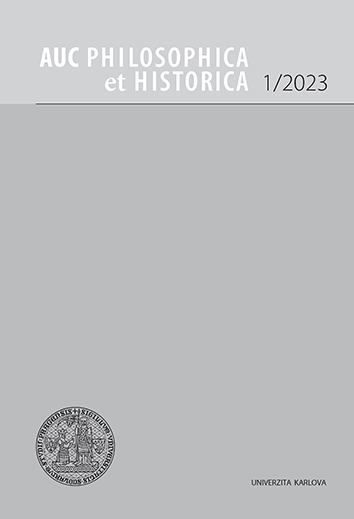AUC Philosophica et Historica je víceoborový akademický časopis zaměřený na humanitní a společenskovědné obory (filozofie, psychologie, pedagogika, sociologie, obecné, české a hospodářské dějiny, pomocné vědy historické a archivnictví, etnologie).
Časopis je indexován v databázích CEEOL, DOAJ a EBSCO.
AUC PHILOSOPHICA ET HISTORICA, Vol 2019 No 2 (2019), 183–191
Jak číst strop? Možnosti vnímání šablonové malby v prostoru středověkého kostela
[How to understand the ceiling? Perception possibilities of stencil paintings within a medieval church]
Eva Csémyová
DOI: https://doi.org/10.14712/24647055.2020.11
zveřejněno: 14. 09. 2020
Abstract
This study deals with possibilities of perception and interpretation of late medieval flat wooden ceilings decorated with stencil painting in Central Europe’s churches. Based on historical sources is shown the long tradition of separating the inner space from the roof and also the custom of its decorating. Therefore, the late medieval ceilings can not be considered as an isolated phenomenon, but a manifestation of a long trace. On the examples of until today preserved ceilings is shown the iconographic interpretation of individual motifs and the fact that their meaning can be further varied due to their mutual position or location in the church space. Outlined is also the question of the existence of an overarching iconographic program for the ceiling decoration.
klíčová slova: stencil painting; wooden flat ceilings; medieval church; medieval art; ornament; polychromy; iconography
reference (17)
1. <bez popisu>
2. Günter Bandmann - Engelbert Kirschbaum, Lexikon der christlichen Ikonographie, Vol. II., Roma 1994.
3. Georg Gottfried Dehio - Gustav von Bezold, Die kirchliche Baukunst des Abendlandes: historisch und systematisch dargestellt, Stuttgart 1892.
4. Nataša Golob, Poslikani leseni stropi v Zahodni Evropi: iz virov za zgodnji in visoki srednji vek, Zbornik za umetnostno zgodovino XXIII, 1987, s. 35-53.
5. Nataša Golob, Bemalte Holzdecken, in: Janez Blažic (ed.), Gotik in Slowenien, Ljubljana 1995, s. 371-377.
6. Janina Eysymontt, Patronowy strop kościoła w Małujowicach, Roczniki Sztuki Śląskiej XI, 1977, s. 7-17.
7. Margareta Faist, Bemalte Holzdecken in Steiermark und Kärnten (disertační práce), Institut für Kunstgeschichte, Karl-Franzens-Universität Graz 1948.
8. Siegfried Hartwagner, Schablonierte sowie bemalte Holzdecken in Kärnten und ihre Restaurierung, Österreichische Zeitschrift für Kunst und Denkmalpflege XXII, 1968, s. 146-164.
9. Eismarie Knögel, Schriftquellen zur Kunstgeschichte der Merowingerzeit, Bonner Jahrbuch CXL-CXLI, 1936, s. 285-290.
10. Manfred Lausmann - Peter Königfeld, Das romanische Deckenbild der Ev. Pfarrkirche St. Michael in Hildesheim, in: Hans-Herbert Möller (ed.), Restaurierung von Kulturdenkmalen. Beispiele aus der niedersächsischen Denkmalpflege II., Hameln, 1989, s. 197-201.
11. Zofia Medwecka, Inwentaryzacja malowideł ściennych w kościele w Dębnie Podhalańskim, Ochrona Zabytków LVII, 1962, s. 19-39.
12. Marc Antoni Nay, Die Bilderdecke von Zillis: Grundlagen und Versuch einer Rekonstruktion, Chur 2015.
13. Theophilus Presbyter, Schedula diversarum artium (Quellenschriften für Kunstgeschichte und Kunsttechnik des Mittelalters und der Renaissance VII), Wien 1874.
14. Julius von Schlosser, Schriftquellen zur Geschichte der karolingischen Kunst, Wien 1896.
15. Uwe Wagner, Die Spätgotische Schablonenmalerei. Zum Stand der Untersuchungen der Schablonenmalereien der Kirche zu Reinstädt, Beiträge zur Erhaltung von Kunstwerken VIII, 1999, s. 21-30.
16. Barbara Wolff-Łozińska, Malowidla stropów polskich 1 połowy XVI w. Dekoracje roślinne i kasetonowe, Warszawa 1971.
17. Rudolf Zeitler, Reclams Kunstführer Schweden, Stuttgart 1985

Jak číst strop? Možnosti vnímání šablonové malby v prostoru středověkého kostela is licensed under a Creative Commons Attribution 4.0 International License.
